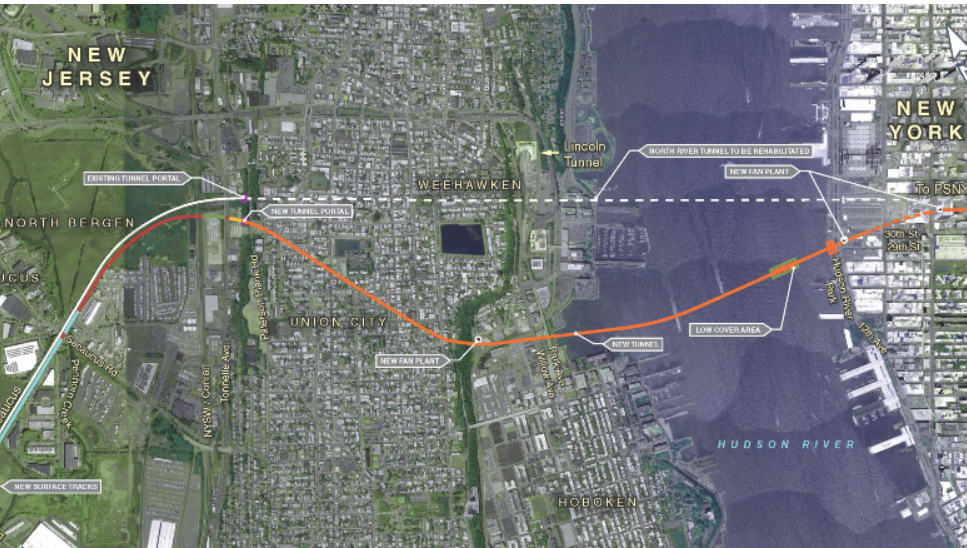耗资 160 亿美元的哈德逊河隧道项目获得最终批准

【中美创新时报2024 年 6 月 12 日编译讯】(记者温友平编译)耗资 160 亿美元的铁路隧道项目 Gateway 的规划人员表示,周二,当联邦政府告诉国会将为该项目额外提供 68.8 亿美元时,他们已经越过了“不归路”。 对此,《纽约时报》记者帕特里克·麦吉汉(Patrick McGeehan)作了下述报道。
联邦拨款——这是该国有史以来提供给公共交通基础设施项目的最高拨款——是新泽西州和曼哈顿宾夕法尼亚车站之间长期推迟的隧道的最后一块资金拼图。
它为这个庞大项目的规划者开了绿灯,让他们聘请工程和建筑公司开始在新泽西州北卑尔根的悬崖上和哈德逊河下进行钻孔。
Gateway 发展委员会首席执行官克里斯·科鲁里(Kris Kolluri)表示,这项工作最早可能在今年开始,计划于 2035 年完成。
“这一刻几乎 30 年来一直没有到来,”科鲁里说道。“我们基本上已经到了无可挽回的地步。”
Gateway 项目是第二次尝试修建一条额外的铁路隧道,以增加容量并提高纽约与西部和南部之间的火车服务的可靠性。现有的两条单轨隧道已有 110 多年的历史,在 2012 年飓风桑迪期间遭受了洪水的破坏。
2010 年,开始为哈德逊河下的另一条铁路隧道让路,该隧道被称为“通往该地区核心区”或 ARC。但在与联邦交通部签署类似的资助协议之前,当时的新泽西州共和党州长克里斯·克里斯蒂(Chris Christie)取消了该项目并向华盛顿退还了部分资金。
上周,纽约州民主党州长凯西·霍楚尔(Kathy Hochul )单方面决定不继续实施在曼哈顿商业区开车收费的计划,这让一些交通专家想起了克里斯蒂的突然举动。
“今天我非常开心,”纽约州民主党多数党领袖、华盛顿 Gateway 项目的最大支持者、参议员查克·舒默 (Chuck Schumer) 说道。“除非发生重大的天灾,否则一切都会顺利。”
联邦政府去年已承诺向 Gateway 提供 68.8 亿美元,但必须制定一份详细的资金协议,其中包括每年约 6 亿美元的联邦预算。周二,联邦运输管理局代理局长维罗妮卡·范特普尔 (Veronica Vanterpool) 通知国会领导人,政府打算在大约两周内与 Gateway 签署该协议。
舒默表示,这笔拨款将使 Gateway 项目的联邦资金增加到约 120 亿美元,约占其预计总成本的 70%。这笔资金中包括拥有现有隧道和宾夕法尼亚车站的美国铁路公司 (Amtrak) 提供的约 10 亿美元。
舒默表示,余额以及任何超支将由纽约和新泽西州提供。
新泽西州民主党州长菲尔·墨菲表示,他认为克里斯蒂对新泽西州承担 ARC 成本超支的担忧“言过其实”。
他补充说,由于纽约州和纽约市官员以及美国铁路公司和纽约新泽西港务局表现出的团队合作精神,他认为他的州“在应对 Gateway 任何意外成本方面处于有利地位”。
“这是哈德逊河两岸的重大胜利,”州长说。
上周,两个州和港务局获得批准,从联邦政府借入他们分担的项目成本。舒默说,这是唐纳德·特朗普担任总统时白宫反对的大型基础设施项目的标准做法。
“特朗普在 Gateway 的道路上设置了许多障碍,”舒默说。“他在担任总统的四年里一直坚持这一点。”
特朗普的继任者乔·拜登在担任参议员时经常乘坐美国铁路公司的火车,并且一直是 Gateway 项目的坚定支持者。
“我们现在要做的下一件事就是执行,而执行并不容易,”美国铁路公司主席兼门户发展委员会副主席安东尼·科西亚 (Anthony R. Coscia) 表示。“我们才刚刚开始,但当我们完成后,现在住在火车服务糟糕的地方的人们将拥有真正高效的火车服务。”
本文最初发表于《纽约时报》。
题图:耗资 161 亿美元的哈德逊河铁路隧道项目效果图。(Gateway供图)
附原英文报道:
$16 billion Hudson River tunnel project gets final green light
By Patrick McGeehan New York Times,Updated June 11, 2024, 6:18 p.m.
The planners of the $16 billion rail tunnel project known as Gateway said they passed the “point of no return” Tuesday when the federal government told Congress that it would provide an additional $6.88 billion to the project.
The federal grant — the most ever provided to a mass-transit infrastructure project in the country — was the final piece of the funding puzzle for the long-delayed tunnel between New Jersey and Penn Station in Manhattan.
It gives planners of the sprawling project the green light to hire engineering and construction companies to start boring through a cliff in North Bergen, N.J., and under the Hudson River.
That work could begin as soon as this year and is scheduled to be completed in 2035, said Kris Kolluri, the CEO of the Gateway Development Commission.
“This is the moment that has eluded this region for literally almost 30 years,” Kolluri said. “We are essentially at the point of no return.”
The Gateway project is the second attempt at building an additional rail tunnel to increase capacity and improve the reliability of train service between New York and points west and south. The existing pair of single-track tunnels is more than 110 years old and suffering from damage sustained by flooding during Hurricane Sandy in 2012.
In 2010, work had begun to make way for a different rail tunnel under the Hudson that was known as Access to the Region’s Core, or ARC. But before signing a similar funding agreement with the federal Department of Transportation, Chris Christie, the Republican governor of New Jersey at the time, canceled the project and returned some money to Washington.
The unilateral decision last week by Kathy Hochul, the Democratic governor of New York, not to go forward with a plan to charge tolls for driving in Manhattan’s business district reminded some transportation experts of that abrupt move by Christie.
“I’m a happy man today,” said Senator Chuck Schumer, the Democratic majority leader from New York and the Gateway project’s biggest champion in Washington. “Barring some major, major, act-of-God catastrophe, it’s all systems go.”
The federal government had pledged the $6.88 billion toward Gateway last year, but a detailed funding agreement that will include about $600 million annually in the federal budget had to be worked out. On Tuesday, Veronica Vanterpool, the acting administrator of the Federal Transit Administration, notified leaders in Congress that the administration intended to sign that agreement with Gateway in about two weeks.
Schumer said that the grant would increase the federal funding for the Gateway project to about $12 billion, about 70 percent of its estimated total cost. That total includes about $1 billion from Amtrak, which owns the existing tunnels and Penn Station.
The balance, along with any overruns, will be supplied by New York and New Jersey, Schumer said.
Phil Murphy, the Democratic governor of New Jersey, said he thought Christie’s stated concern about New Jersey shouldering cost overruns for ARC was “overblown.”
He added that he thought his state was “in a good place in terms of exposure” to any unexpected costs of Gateway because of the teamwork demonstrated by New York state and city officials, as well as Amtrak and the Port Authority of New York and New Jersey.
“This is a big win for both sides of the Hudson,” the governor said.
Last week, the two states and the Port Authority received approval to borrow their shares of the project’s cost from the federal government. That is a standard practice for major infrastructure projects that was opposed by the White House when Donald Trump was president, Schumer said.
“Trump put many roadblocks in the way of Gateway,” Schumer said. “He held it up for all four years that he was president.”
Trump’s successor, Joe Biden, was a regular rider of Amtrak trains when he was a senator and has been a strong supporter of the Gateway project.
“The next thing we now have to do is execute, and execution isn’t easy,” said Anthony R. Coscia, chair of Amtrak and vice chair of the Gateway Development Commission. “We’re just getting started, but when we’re done, people who live in places now where the train service is terrible are going to have really efficient train service.”
This article originally appeared in The New York Times.

